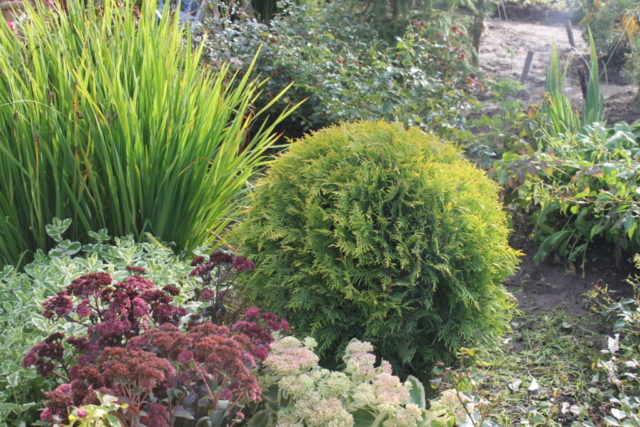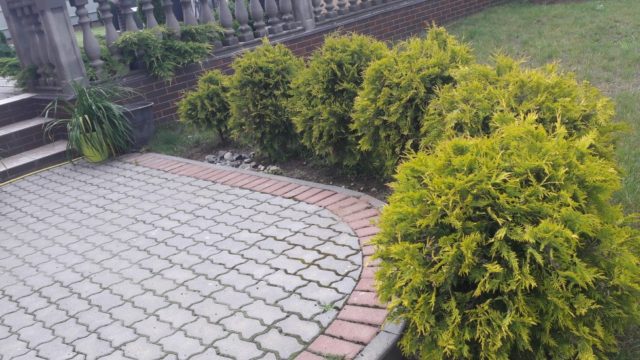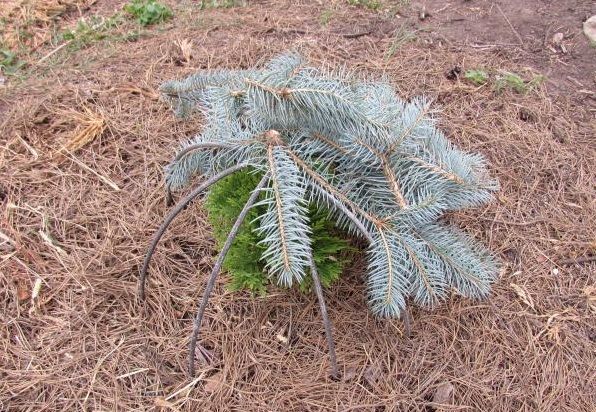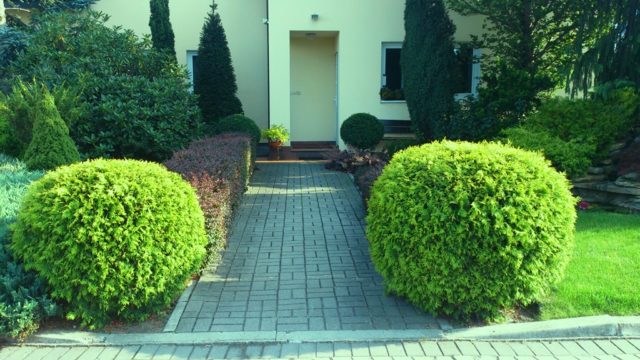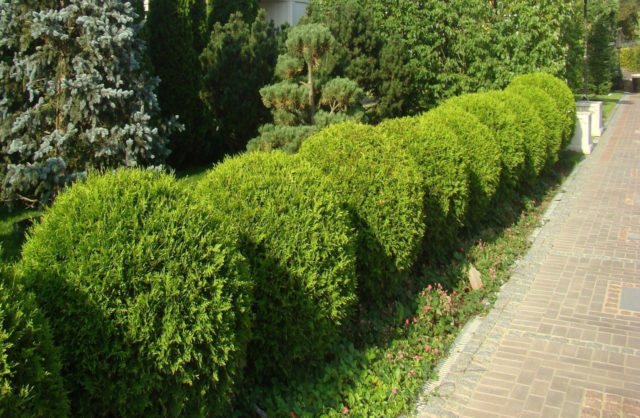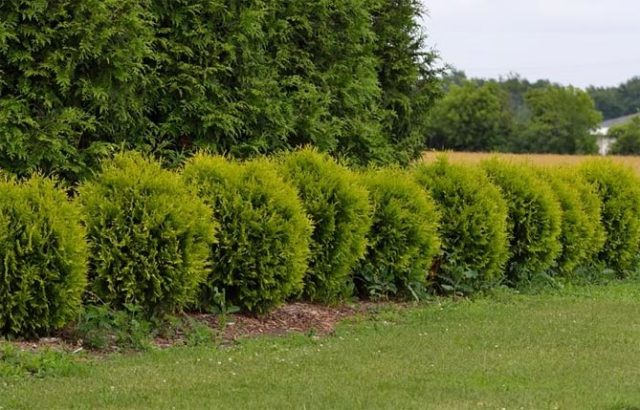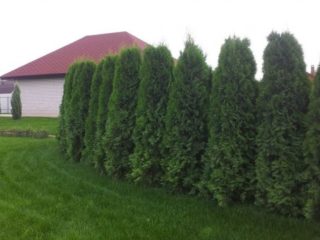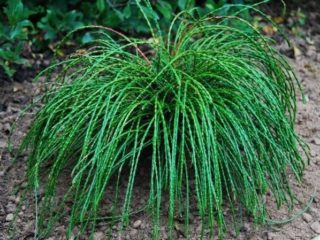Content
Thuja Golden Globe is a highly decorative coniferous shrub with a spherical crown that is easy to prune. The western thuja is planted in sunny areas with fertile soil. Caring for the thuja variety is not laborious, but requires knowledge of the specifics of growing conifers.
Description of Tui Golden Globe
The dwarf coniferous shrub thuja Golden Glob, as in the photo, grows to 75-80 cm after 10 years. It reaches its maximum height of 1-1.5 m by the age of 20. Shoots in a year stretch only 8-10 cm. The diameter of the dense crown of a low western thuja is equal to the height, but adult specimens of the Golden Globe variety acquire an oval shape without a haircut. The bark on the branches and trunk is red-brown, exfoliating in narrow stripes. The root system of the western thuja is located close to the surface. Although there are 1-3 taproots extending deep into the soil, thanks to which the shrub withstands short-term droughts.
The needles in the middle of the crown of the Golden Globe thuja are bright green. Above, on all extreme shoots, it becomes golden in summer and orange-copper in winter. In the spring it turns yellow again. Especially expressive color of the thuja Golden Glob variety, if the bush grows in an open space. In the shade, the golden hue is lost, the crown becomes sparse and loose, the silhouette of the sphere disappears. But in the south, the western thuja bush will suffer from direct sunlight and hot air. Bushes in such regions are best placed in partial shade.
All the signs of the Golden Glob shrub variety show if:
- planted in fertile soil;
- the roots do not suffer from stagnant water;
- the crown is well illuminated by the sun;
- in winter, in areas with heavy snowfalls, the branches are tied so that they do not break off;
- in February-March, young trees are covered with a shading net;
- the climate is mild, humid, not arid.
The decorative coniferous bush Golden Globe is frost-resistant, tolerates sub-zero temperatures up to 38 ° C. A beautiful variety of western thuja is planted in the middle climatic zone, but not on soils with high acidity.
The use of thuja Golden Globe in landscape design
A dwarf variety of western thuja with golden needles is acquired by gardeners who prefer bright accents throughout the year. A small tree with a beautiful silhouette and warm color is a real find for a small garden. Judging by the photo, thuja Golden Globe in landscape design is used for various purposes:
- compact tree for the entrance area;
- curb plantings;
- an element of the composition of conifers in an evergreen flower bed;
- soloist on the lawn;
- a tree for a rock garden or rockery;
- evergreen scenic bush in a container.
Breeding features
Thuja western rooted easily, so the beautiful Golden Globe bush is often propagated by cuttings or branches from the mother plant. Varietal thuja are not propagated by seeds if they want to preserve all the selective features. The traits of the variety will be transmitted through the vegetative fragment. Experts propagate the Golden Glob variety by grafting.
From seeds, the sprout will turn into a bush at 5-6 years of development. Before sowing, the grains of thuja western harvested in the fall are stratified in the refrigerator or sown directly into the soil in the garden in the fall. Seedlings appear in spring.
Cutting is an easier method. Reproduction is carried out in the summer, in late June, early July, when the shoots have already grown over the spring. It is important to cut the stem from a straight, healthy shoot within the crown. The twig is cut or broken off so as to capture part of last year's bark. Usually, the shoot is abruptly torn off, and then part of the old wood is separated. Due to this material, the western thuja stalk can take root more easily.
The twigs are treated with a root stimulator and planted in a loose substrate right in the garden or in a container. A greenhouse is arranged over them and sprayed daily. After rooting, the sprouts are opened. For the winter, the seedlings of thuja western Golden Glob, as seen in the photo, are insulated with spruce branches.
Planting and caring for thuja Golden Glob
Having chosen the right place for the western thuja and enriching the substrate according to the advice, gardeners know that it will develop successfully.
Recommended timing
The ornamental shrub Golden Globe is planted in the spring, even at the beginning of June. Usually, thuja seedlings are purchased in nurseries in pots, and they tolerate summer movement well. In regions with a long autumn period, conifers are planted in September so that they have time to take root before the onset of frost.
Site selection and soil preparation
For the colorful variety Golden Glob, they choose a cozy area protected from the wind. Thuja grows best on neutral soil with an acid reaction of 4.5-6 pH. Survives on alkaline soil, but too acidic soil is unacceptable. In areas with heavy soil, a larger hole is dug to lay drainage up to 15 cm high and a substrate with sand and peat. Thuja roots love loose soil: loam and sandy loam. For the substrate, prepare 1 part of peat and sand, 2 parts of soil from the site. The planting mixture is enriched with nitroammophos or any special fertilizer for conifers.
Landing algorithm
Having dug a planting hole 60x80 cm in size, drainage is placed below, and then a nutritious substrate:
- before planting, the container with the Golden Globe bush is placed in a large container with water, after which it is easy to separate the earthen lump with overgrown roots;
- the shoots are slightly straightened on the soil;
- a thuja seedling is placed, making sure that the root collar does not go deeper, but is at ground level in the garden;
- sprinkle a hole, compact the earth around the trunk and water 10-15 liters of water;
- it is good to mulch the tree trunk right now so that moisture remains and weeds do not grow.
Growing and care rules
The seedling is carefully looked after. Thuja western Golden Glob, according to the photo and description, forms a spherical crown. It becomes more lush and dense in appearance after pruning, which is best done once a year.
Watering schedule
Considering that nutrients remained in the earthen coma, which were fed to the seedlings in the nursery, the young tree is watered abundantly - up to 10-15 liters of water once every 5-7 days, guided by the precipitation. If the soil is open, the trunk circle is loosened after watering, weeds are removed. During the drought period, the thuja is watered with 20 liters of water every 3-4 days. Sprinkling is carried out in the evening. When an adult thuja bush is left without moisture in a dry season, it will begin to form fruits, which will reduce the decorative effect of the Golden Globe variety.
Top dressing
If there were enough starting fertilizers, usually in the first year and the subsequent feeding of the thuja is not carried out. Organic fertilizers are also not used for the species, especially fresh ones, which can damage the roots. Compost is allowed for mulch before winter. They use mainly only mineral preparations - universal or special, for conifers.
Pruning
Thuja Golden Glob bush is cleaned of dry branches in spring. At the same time, formative pruning is carried out. The variety is also cut in summer. When pruning, the golden background of the bush changes slightly, as the branches turn yellow at the tops. But soon the shoots will grow with several new branches, making the silhouette of the Golden Globe thuja more magnificent, as follows from the description and photo. Cut the crown carefully, removing 1/2 or 1/3 of the spring growth of the shoot.If you delete an entire new branch, the crown will not recover. There are no dormant buds on the lignified parts.
Preparing for winter
The seedling is especially carefully prepared for winter, because the frost-resistant tree has grown up:
- thuja are watered abundantly at the end of September or in October - 25-30 liters for a young bush and up to 40 liters for an old one;
- put mulch to the trunk and along the perimeter of the roots with a layer of up to 10-15 cm;
- in areas where a lot of snow falls, branches are tied to the trunk;
- the seedlings are covered with spruce branches, burlap or the remains of vegetation.
Pests and diseases
The branches of the species damage aphids, pseudo-scale insects and spider mites. They use drugs against them:
- Actellik;
- Engio;
- Aktara;
- Confidor and others.
In the spring, prophylaxis with fungicides is carried out, preventing the development of fungal diseases:
- Quadris;
- Horus;
- Maksim;
- Speed
Conclusion
Thuya Golden Globe is an unpretentious and effective variety that will bring zest to the garden, enlivening any corner with golden needles. Due to the compactness of the crown, the crop is popular as a container plant.
